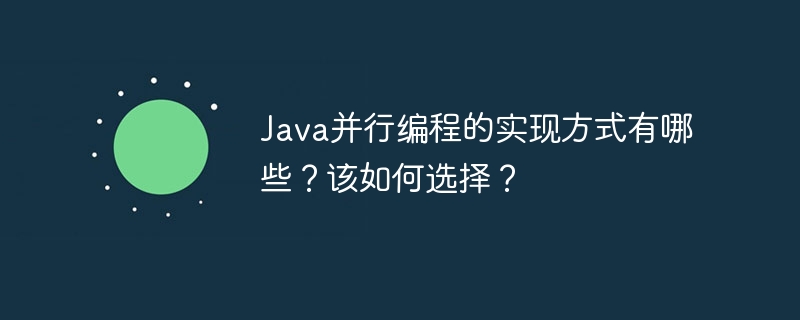 Java
Java
 javaTutorial
javaTutorial
 What are the implementation methods of parallel programming in Java? How to choose?
What are the implementation methods of parallel programming in Java? How to choose?
What are the implementation methods of parallel programming in Java? How to choose?
Java parallel programming implementation methods: 1. Multi-threading, 2. Thread pool, 3. Lock, 4. Atomic variables. Choosing the appropriate method depends on the requirements, for example: High throughput: multi-threading or thread pool Low response time: threads Pool or atomic variable resources are limited: thread pool or lock

Java parallel programming implementation
Java provides a variety of Mechanisms to implement parallel programming, including:
- Multi-threading: Create and run multiple threads of simultaneous execution.
- Thread pool: Manage and reuse threads to improve performance.
- Lock: Used to coordinate access to shared resources and prevent conflicts.
- Atomic variables: Provides thread-safe variables for update operations.
How to choose the appropriate implementation method?
Choosing the appropriate parallel programming implementation depends on the needs of the application:
- High throughput: Multiple threads or thread pools.
- Low response time: Thread pool or atomic variables.
- Resource limited: Thread pool or lock.
Practical case:
Use thread pool to improve throughput:
import java.util.concurrent.ExecutorService;
import java.util.concurrent.Executors;
public class ThreadPoolDemo {
public static void main(String[] args) {
// 创建一个固定大小的线程池
ExecutorService executor = Executors.newFixedThreadPool(10);
// 创建任务
Runnable task = () -> {
System.out.println("Hello from thread " + Thread.currentThread().getName());
};
// 提交任务到线程池
for (int i = 0; i < 100; i++) {
executor.submit(task);
}
// 等待所有任务完成
executor.shutdown();
while (!executor.isTerminated()) {
try {
Thread.sleep(100);
} catch (InterruptedException e) {
e.printStackTrace();
}
}
}
}Use atomic variables Implement thread safety:
import java.util.concurrent.atomic.AtomicInteger;
public class AtomicVariableDemo {
public static void main(String[] args) {
// 创建一个原子整数
AtomicInteger counter = new AtomicInteger(0);
// 两个线程同时更新计数器
Thread thread1 = new Thread(() -> {
for (int i = 0; i < 100000; i++) {
counter.incrementAndGet();
}
});
Thread thread2 = new Thread(() -> {
for (int i = 0; i < 100000; i++) {
counter.incrementAndGet();
}
});
thread1.start();
thread2.start();
// 等待线程完成
try {
thread1.join();
thread2.join();
} catch (InterruptedException e) {
e.printStackTrace();
}
// 打印最终计数器值
System.out.println("Final count: " + counter.get());
}
}The above is the detailed content of What are the implementation methods of parallel programming in Java? How to choose?. For more information, please follow other related articles on the PHP Chinese website!

Hot AI Tools

Undresser.AI Undress
AI-powered app for creating realistic nude photos

AI Clothes Remover
Online AI tool for removing clothes from photos.

Undress AI Tool
Undress images for free

Clothoff.io
AI clothes remover

AI Hentai Generator
Generate AI Hentai for free.

Hot Article

Hot Tools

Notepad++7.3.1
Easy-to-use and free code editor

SublimeText3 Chinese version
Chinese version, very easy to use

Zend Studio 13.0.1
Powerful PHP integrated development environment

Dreamweaver CS6
Visual web development tools

SublimeText3 Mac version
God-level code editing software (SublimeText3)

Hot Topics
 1378
1378
 52
52
 Perfect Number in Java
Aug 30, 2024 pm 04:28 PM
Perfect Number in Java
Aug 30, 2024 pm 04:28 PM
Guide to Perfect Number in Java. Here we discuss the Definition, How to check Perfect number in Java?, examples with code implementation.
 Random Number Generator in Java
Aug 30, 2024 pm 04:27 PM
Random Number Generator in Java
Aug 30, 2024 pm 04:27 PM
Guide to Random Number Generator in Java. Here we discuss Functions in Java with examples and two different Generators with ther examples.
 Weka in Java
Aug 30, 2024 pm 04:28 PM
Weka in Java
Aug 30, 2024 pm 04:28 PM
Guide to Weka in Java. Here we discuss the Introduction, how to use weka java, the type of platform, and advantages with examples.
 Smith Number in Java
Aug 30, 2024 pm 04:28 PM
Smith Number in Java
Aug 30, 2024 pm 04:28 PM
Guide to Smith Number in Java. Here we discuss the Definition, How to check smith number in Java? example with code implementation.
 Java Spring Interview Questions
Aug 30, 2024 pm 04:29 PM
Java Spring Interview Questions
Aug 30, 2024 pm 04:29 PM
In this article, we have kept the most asked Java Spring Interview Questions with their detailed answers. So that you can crack the interview.
 Break or return from Java 8 stream forEach?
Feb 07, 2025 pm 12:09 PM
Break or return from Java 8 stream forEach?
Feb 07, 2025 pm 12:09 PM
Java 8 introduces the Stream API, providing a powerful and expressive way to process data collections. However, a common question when using Stream is: How to break or return from a forEach operation? Traditional loops allow for early interruption or return, but Stream's forEach method does not directly support this method. This article will explain the reasons and explore alternative methods for implementing premature termination in Stream processing systems. Further reading: Java Stream API improvements Understand Stream forEach The forEach method is a terminal operation that performs one operation on each element in the Stream. Its design intention is
 TimeStamp to Date in Java
Aug 30, 2024 pm 04:28 PM
TimeStamp to Date in Java
Aug 30, 2024 pm 04:28 PM
Guide to TimeStamp to Date in Java. Here we also discuss the introduction and how to convert timestamp to date in java along with examples.
 Create the Future: Java Programming for Absolute Beginners
Oct 13, 2024 pm 01:32 PM
Create the Future: Java Programming for Absolute Beginners
Oct 13, 2024 pm 01:32 PM
Java is a popular programming language that can be learned by both beginners and experienced developers. This tutorial starts with basic concepts and progresses through advanced topics. After installing the Java Development Kit, you can practice programming by creating a simple "Hello, World!" program. After you understand the code, use the command prompt to compile and run the program, and "Hello, World!" will be output on the console. Learning Java starts your programming journey, and as your mastery deepens, you can create more complex applications.



